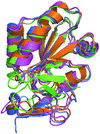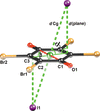issue contents
March 2023 issue

editorial
MATERIALS | COMPUTATION
This editorial gives gives an update on the current status of crystal structure prediction and its opportunities and challenges.
scientific commentaries
CHEMISTRY | CRYSTENG
A long-asked question concerning the dominant component of strong π-hole interactions is addressed.
research letters
BIOLOGY | MEDICINE
A 1.20 Å high-resolution structure of thioredoxin 2 (Trx2) from Acinetobacter baumannii (abTrx2) is elucidated. Based on comparison of structure and activity with Trx1, it is revealed that the two Trxs in A. baumannii possess similar activity, although Trx2 contains an additional N-terminal zinc-finger domain and exhibits more flexible and dynamic properties in solution.
PDB reference: Trx2 from Acinetobacter baumannii, 7ysi
research papers
CHEMISTRY | CRYSTENG
Download citation


Download citation


Analysis of charge density in a π-hole contact between an iodide anion and tetrabromoquinone reveals the nature of the interaction as dominantly electrostatic with a significant dispersion component. The quinoid ring has a partial negative charge (estimated to be in the range 0.08–0.11e) and a partial radical character and the energy of the interaction is estimated to be −11.16 kcal mol−1.
CCDC reference: 2234264
CHEMISTRY | CRYSTENG
Download citation


Download citation


A series of multicomponent cocrystal solvates of chiral dihydromyricetin with caffeine (CAF) or theophylline (THE) crystallized as two distinct types of solid solution differing in mixing scale of enantiomers spanning several orders of magnitude. This remarkable impact on enantiomer discrimination was simply achieved by the reduction of a methyl group of CAF to the THE coformer, which was attributed to the hydrogen-bonding donor–acceptor capacity coformers.
CHEMISTRY | CRYSTENG
The self-repairing nature of rapid YBa2Cu3O7−δ growth with overgrowing features is revealed and non-equilibrium morphology is demonstrated to be a prerequisite self-repairing activator.
BIOLOGY | MEDICINE
The hierarchical organization of bone is a key feature of this important biomineralized tissue. A combination of small- and wide-angle X-ray scattering tensor tomography with diffraction tomography and synchrotron computed tomography demonstrates how mineral properties and the orientational relationship between mineral and nanostructure vary across the tissue.
MATERIALS | COMPUTATION
Very high-resolution X-ray scattering data are used to study the disordered structure of Cu2−xSe in the high-temperature superionic phase.
CHEMISTRY | CRYSTENG
Download citation


Download citation


Four different mechanisms of solvate formation were observed and explained for four solvates of the pharmaceutical substance ibrutinib with the series of solvents fluorobenzene, chlorobenzene, bromobenzene and iodobenzene.
BIOLOGY | MEDICINE
Crystal structures of PsEst3 complexed with various ligands and its biochemical characterization indicate the emergence of a new GHSR-type lipase/esterase and reveal the relationship between its structure and function.
BIOLOGY | MEDICINE
The EF-hands within the crystal structures of the Zn2+-bound EFhd1 and EFhd2 core domains coordinate Zn2+ ions. EFhd1 and EFhd2 exhibited Ca2+- and Zn2+-independent actin binding and Ca2+- and Zn2+-dependent actin-bundling activity, and these suggest the possibility that both Ca2+ and Zn2+ act to regulate EFhd1 and EFhd2 in physiological processes.


 journal menu
journal menu




 access
access























